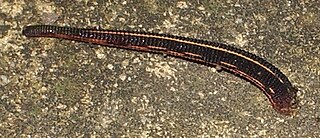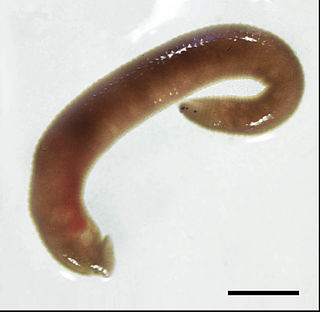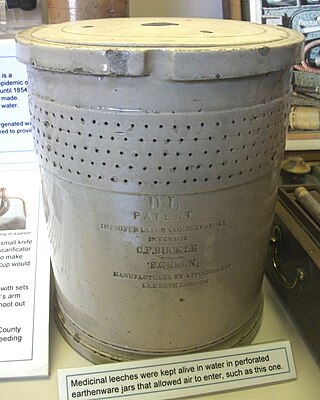
Hirudo medicinalis, the European medicinal leech, is one of several species of leeches used as "medicinal leeches".

Machairodontinae is an extinct subfamily of carnivoran mammals of the family Felidae. They were found in Asia, Africa, North America, South America, and Europe from the Miocene to the Pleistocene, living from about 16 million until about 11,000 years ago.

Rhynchobdellida, the jawless leeches or freshwater leeches, are an order of aquatic leeches. Despite the common name "freshwater leeches", species are found in both sea and fresh water. They are defined by the presence of a protrusible proboscis instead of jaws, and having colourless blood. They move by "inchworming" and are found worldwide. The order contains 110 species, divided into 41 genera and three families. Members of the order range widely in length, usually between 7 and 40 mm. They are hermaphrodite.

Sphenacodontidae is an extinct family of small to large, advanced, carnivorous, Late Pennsylvanian to middle Permian pelycosaurs. The most recent one, Dimetrodon angelensis, is from the late Kungurian or early Roadian San Angelo Formation. However, given the notorious incompleteness of the fossil record, a recent study concluded that the Sphenacodontidae may have become extinct as recently as the early Capitanian. Primitive forms were generally small, but during the later part of the early Permian these animals grew progressively larger, to become the top predators of their environments. Sphenacodontid fossils are so far known only from North America and Europe.

Haemadipsidae are a family of jawed leeches. They are a monophyletic group of hirudiniform proboscisless leeches. These leeches have five pairs of eyes, with the last two separated by two eyeless segments. The family is monotypic, containing only the subfamily Haemadipsinae, though as the family can apparently be divided into two or three distinct lineages, at least one of the proposed splits, while not a distinct family, might be a valid subfamily.

Inostrancevia is an extinct genus of carnivorous therapsids, containing the largest members of gorgonopsians, predators characterized by long, saber-tooth-like canines. The various species inhabited European Russia during the Upper Tatarian (Vyatskian), a Russian regional stage equivalent to the Wuchiapingian and Changhsingian stage of the Late Permian period, dating from approximately 259 to 252.3 million years ago. The genus name was described posthumously, after the Bolshevik Revolution, by the Russian paleontologist Vladimir P. Amalitsky in 1922, in honor of geologist Aleksandr Inostrantsev.

Euhirudinea, the true leeches, are an infraclass of the Hirudinea.

Arhynchobdellida, the proboscisless leeches, are classified as an order of the Hirudinea. More recently, this order has been rejected and replaced with a newer classification. Still, leech taxonomy and systematics may eventually need to be revised, not because of the many uncertainties exist about their phylogeny, but because the major clades of clitellate annelids - and whether the clitellates are themselves a clade - have not been fully elucidated. For example, the "true leeches" (Euhirudinea) might actually be synonymous with the Hirudinea, as all other leech-like annelids might not be very closely related to the true leeches.

Leeches are segmented parasitic or predatory worms that comprise the subclass Hirudinea within the phylum Annelida. They are closely related to the oligochaetes, which include the earthworm, and like them have soft, muscular segmented bodies that can lengthen and contract. Both groups are hermaphrodites and have a clitellum, but leeches typically differ from the oligochaetes in having suckers at both ends and in having ring markings that do not correspond with their internal segmentation. The body is muscular and relatively solid, and the coelom, the spacious body cavity found in other annelids, is reduced to small channels.

Xerobdellidae are a small family of "jawed leeches". The latter might be a natural, monophyletic group of hirudiniform proboscisless leeches. Xerobdellidae have three jaws and five pairs of eyes, the fourth and fifth being separated by one or two eyeless segments. The genera placed herein occur in Chile (Mesobdella), Europe (Xerobdella) and Diestecostoma is found in Central and northern South America. This peculiar distribution strongly suggests they are a relict Pangaean group, which had already been present by the start of the Jurassic 250 million years ago.

Phytobdella catenifera is a large terrestrial leech found in Peninsular Malaysia. John Percy Moore chose this species’ epithet ‘catenifera’ after the striking chain-striped pattern on the creature's back.

A tooth is a hard, calcified structure found in the jaws of many vertebrates and used to break down food. Some animals, particularly carnivores and omnivores, also use teeth to help with capturing or wounding prey, tearing food, for defensive purposes, to intimidate other animals often including their own, or to carry prey or their young. The roots of teeth are covered by gums. Teeth are not made of bone, but rather of multiple tissues of varying density and hardness that originate from the embryonic germ layer, the ectoderm.

Hirudobdella antipodum is a terrestrial leech found only on the Open Bay Islands in New Zealand. It preys on the feet of nesting seabirds. Its numbers have been reduced significantly by introduced weka, and the entire remnant population of the leech is now living beneath a single boulder.

A sucker in zoology refers to a specialised attachment organ of an animal. It acts as an adhesion device in parasitic worms, several flatworms, cephalopods, certain fishes, amphibians, and bats. It is a muscular structure for suction on a host or substrate. In parasitic annelids, flatworms and roundworms, suckers are the organs of attachment to the host tissues. In tapeworms and flukes, they are a parasitic adaptation for attachment on the internal tissues of the host, such as intestines and blood vessels. In roundworms and flatworms they serve as attachment between individuals particularly during mating. In annelids, a sucker can be both a functional mouth and a locomotory organ. The structure and number of suckers are often used as basic taxonomic diagnosis between different species, since they are unique in each species. In tapeworms there are two distinct classes of suckers, namely "bothridia" for true suckers, and "bothria" for false suckers. In digeneal flukes there are usually an oral sucker at the mouth and a ventral sucker posterior to the mouth. Roundworms have their sucker just in front of the anus; hence it is often called a pre-anal sucker.

A leech collector, leech gatherer, or leech finder was a person occupied with procuring medicinal leeches, which were in growing demand in 19th-century Europe. Leeches were used in bloodletting but were not easy for medical practitioners to obtain. The collector would sometimes gather the leeches by attracting them to the legs of animals, often old horses. More commonplace was for the collector to use their own legs, gathering the leech after it had finished sucking enough blood. Many in the profession suffered from the effects of the loss of blood and infections spread by the leeches.

Haemopis sanguisuga is a species of freshwater leech in the family Haemopidae. It is commonly called the horse-leech, but that is due to the similarity of its appearance to the leech Limnatis nilotica, which sometimes enters the nasal cavities of livestock. Haemopis sanguisuga does not behave in this way. Another synonym for this leech is Aulastomum gulo.

Hirudo is a genus of leeches of the family Hirudinidae. It was described by Carl Linnaeus in his landmark 1758 10th edition of Systema Naturae.

Erpobdellidae is a family of leeches. It is one of the four families belonging to the suborder Erpobdelliformes of the proboscisless leeches order, Arhynchobdellida.
Hirudo orientalis is a species of medicinal leech. It has been confused with Hirudo medicinalis, but has recently been recognized as a different species. This Asian species is associated with mountainous areas in the subboreal eremial zone and occurs in Azerbaijan, Iran, Uzbekistan and Kazakhstan. It occurs also in Georgia, and probably in Armenia.
Orobdella ketagalan is a species of terrestrial leech in the order Arhynchobdellida, the proboscisless leeches. It is endemic to northern Taiwan. It is known from the vicinity of Taipei, including its type locality, Yangmingshan National Park. The specific name refers to the native Taiwanese Ketagalan people inhabiting the area. The closest known relative of Orobdella ketagalan is Orobdella meisai from southern Taiwan, followed by Orobdella dolichopharynx and Orobdella shimadae from the Ryukyu Islands (Japan).


















